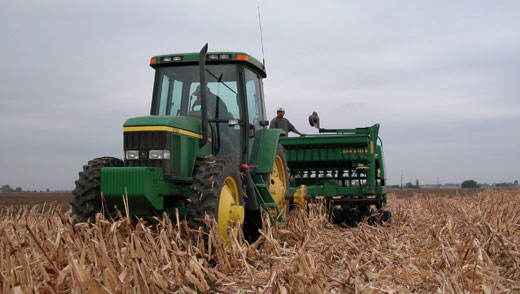| • Table of Contents • |
Fall 2006 - Vol. 7/No. 1
Weed control in conservation tillage systems
A reduction in tillage operations saves fuel, time and reduces dust, but also makes weed control more challenging. Tillage for weed control uproots weeds or cuts the the “roots-to-shoots” connection of weeds, and thus prevents them from competing with the crop. Tillage is also used to incorporate certain herbicides, moving them into the soil where they are active. In contemplating the shift to conservation tillage, how will weeds be managed? A few options include subsurface drip irrigation, mulches, a propane flamer, and certain herbicides.
 No-till cover crop planting into corn residue at SAFS site. (photo by Gene Miyao) |
Subsurface drip irrigation can help to prevent weed emergence. Weed seeds typically germinate near the soil surface when environmental conditions are favorable. In a dry climate, lack of moisture can prevent seeds from germinating. Rainfall generally does not occur in sufficient quantities to allow weed seeds to germinate during the typical summer growing season in California. Therefore, burying a drip tape and restricting moisture to the crop root zone can prevent weed seed germination. We examined the use of subsurface drip irrigation in a reduced tillage processing tomato system and were able to maintain or improve tomato yields in both years of the study, reduce water use and reduce weed densities by 98 percent. This system works for annual weeds emerging from seed, but is ineffective against established perennials.
Mulches or cover crops that are left on the surface can help shade the ground and also reduce weed emergence. The thicker the mulch layer, the more effective is the weed control. However, mulches also create problems. Planting into thick mulch requires special attachments to cut and move the thatch from the seed line to improve planting conditions. In the process, the removal of the mulch may allow weeds to germinate in the crop row. Cover crop mulches may also reduce soil moisture. In addition, soil temperatures under the mulch are lower than bare soil, which reduces heat units needed for seedling growth. Later in the season, cultivation is often required for weed control where trash from the mulch is often an operational problem for conventional cultivation equipment. Rodents such as gophers may be an increased problem with cover crop vegetation. During furrow irrigation, mulches can partially block water movement, often a problem for efficient water management. At harvest, mulches may create more dust as equipment picks up debris.
Flaming can control small emerged weeds, but is not effective against grasses or larger weeds. Flaming does not require igniting the weed; it is simply necessary to heat the leaves to approximately 130 degrees Fahrenheit, until the membranes burst. If a plant has been sufficiently flamed, it should be possible to press the leaf between thumb and fingers and leave a finger impression. Broadleaf weed seedlings are easily controlled. In our study, we used sprinkler irrigation to stimulate weed germination. We flamed this area 14 days later and were able to control emerged weeds with the flamer. Pre-irrigation followed by flaming reduced in-season weed density in fields with high weed densities, but did not improve weed control in a field with low weed densities. We unsuccessfully used a liquid propane flamer to control large winter weeds in a reduced tillage system. The rising cost of liquid propane makes this option less economical. The risk of fire should be considered in areas where dry vegetation is near.
Herbicides have allowed Midwest corn and soybean farmers to shift to notill crop production. In California, fewer herbicide options are available. In corn, herbicides that require incorporation may not be effective in no-tillage systems unless they can be moved into the soil by furrow irrigation. Sprinkler irrigation can move many of these herbicides into the soil but are not economical for corn production. Postemergence herbicides are key to no-tillage systems. Statewide, the trend is toward postemergence in all corn production. Growers throughout California use Roundup Ready® (RR) corn technologies in both no-till and standard-till production. Most growers rotate portions of their corn acreages with RR and conventional corn varieties depending on weed pressures, to reduce seed cost and avoidance of weed resistance. We have examined RR corn in a no-till system, with good results for weed control and yields. In tomato, fall bed herbicides are generally moved into the soil by rainfall, so tillage may not be important if timely rainfall occurs. Trifluralin (Treflan®), which requires mechanical incorporation, would not be used in a no-till system. In our system, which lacked sprinkler irrigation, rimsulfuron (Matrix®) provided initial control of emerged weeds, but residual activity was very limited compared to other locations where sprinkler irrigation and cultivation were both used.
There is growing interest in conservation tillage practices in California that reduce environmental degradation and cut crop production inputs. In contrast, weed control remains a great challenge. Development of effective weed control strategies and new management systems in conservation tillage is necessary. Our continuous research emphasis will be to find potential mechanisms to suppress weeds in conservation tillage and increase knowledge of sustainable agricultural practices for crop production.